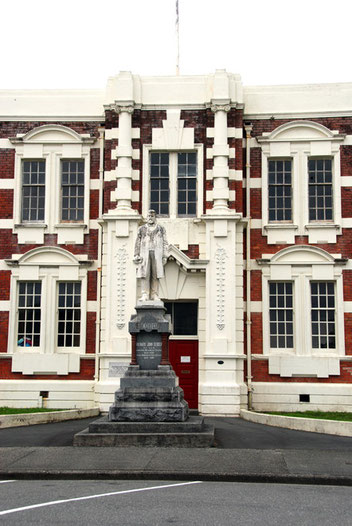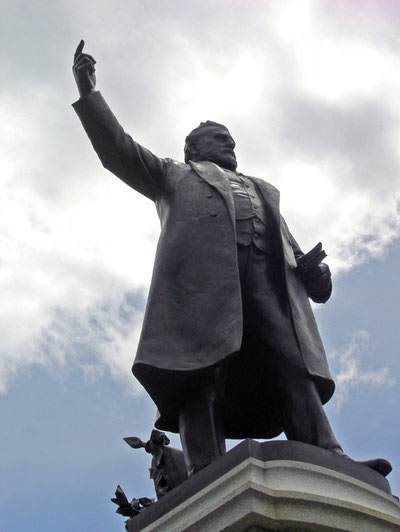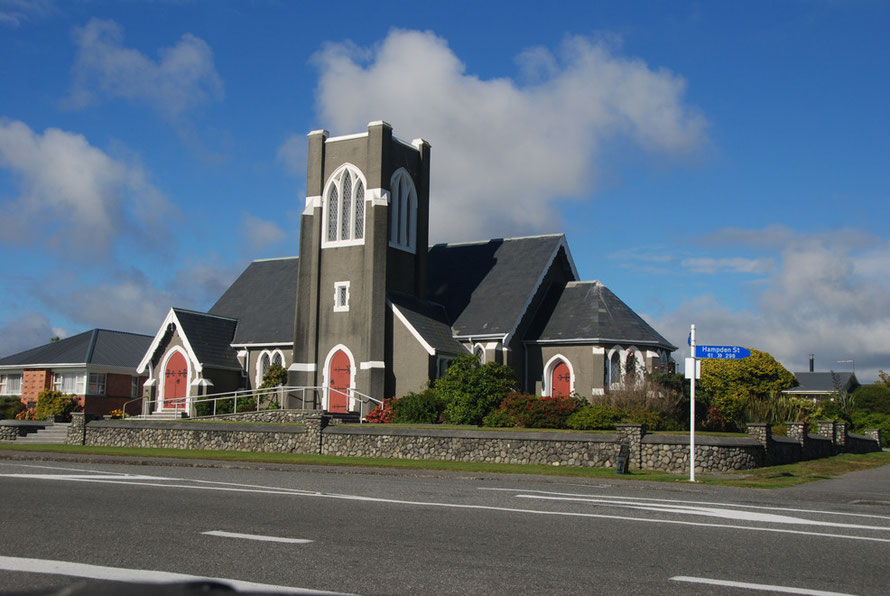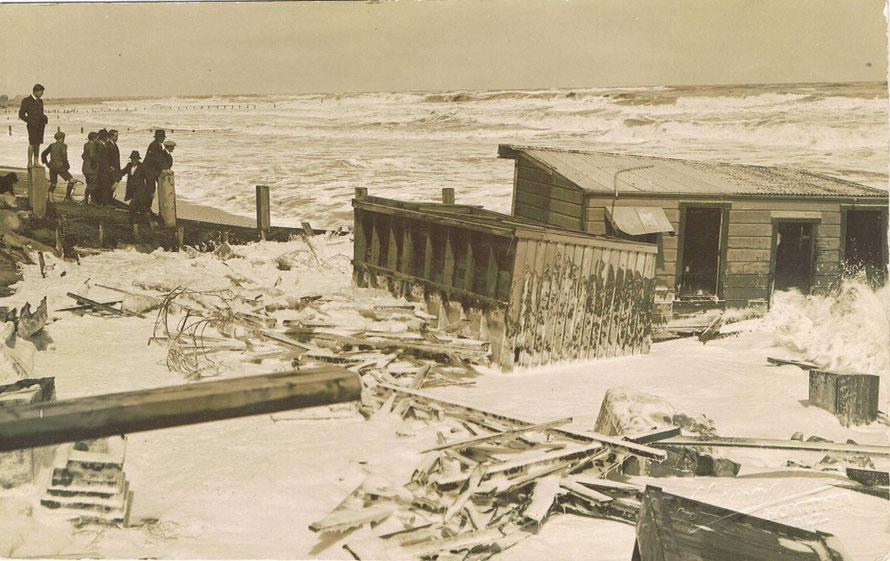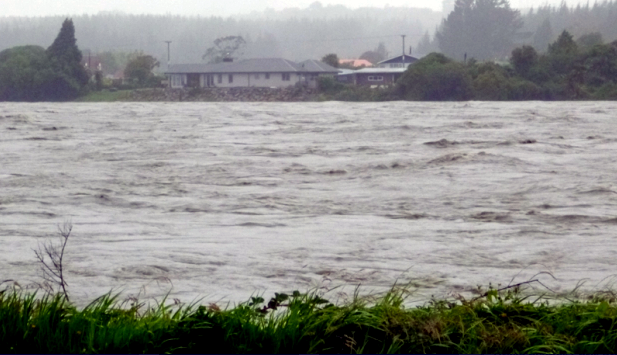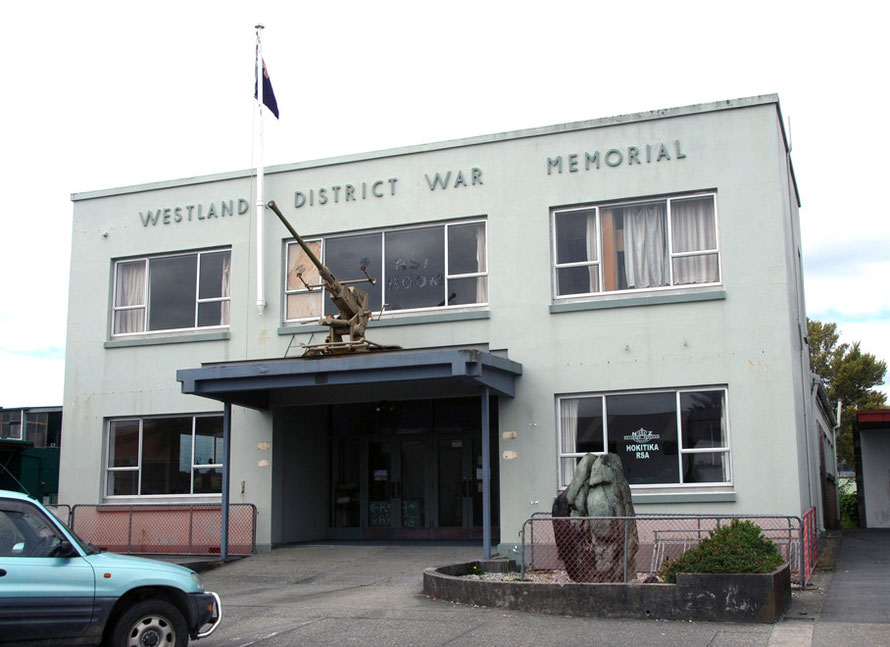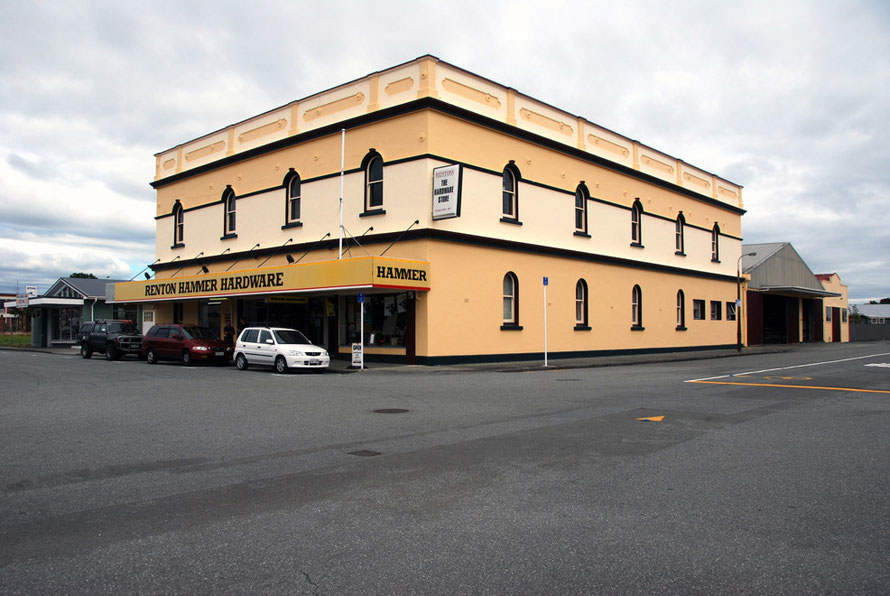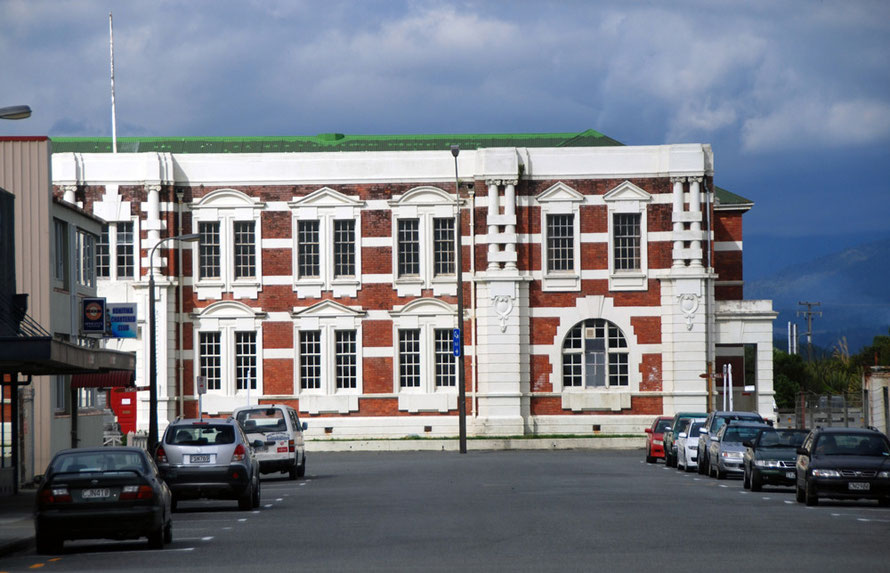IV. Gold Town: Hokitika
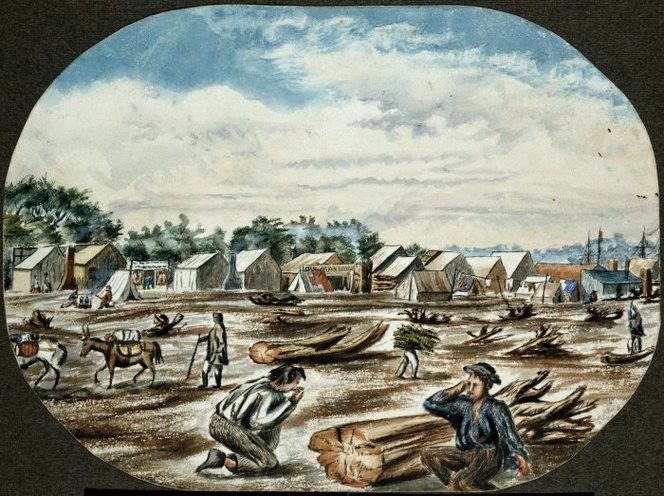
We went to Hokitika - you would have to make an effort not to - on our way up the West Coast. Indeed 'Hokitika is the only West Coast town seen by many tourists' (Te Ara: Hokitika).
"When Queen Elizabeth II and the Duke of Edinburgh visited the West Coast in January 1954, they flew ... to Hokitika. It was planned that they would travel by road from Hokitika to Greymouth. To make sure that the royal journey was as smooth as possible, the road was sealed [tarmacked] – but, to save money, only the side on which the car would travel. For several years, before the whole road was sealed, this was known by locals as ‘Lizzie’s side’" (see Te Ara above).
Hokitika was sold to us in the Rough Guide as a happening arty place. I had visions of a sort of gold-town-cum-St Ives-Cornwall. In fact it turned out to remind me more of Hayle further north on the Cornish coast.
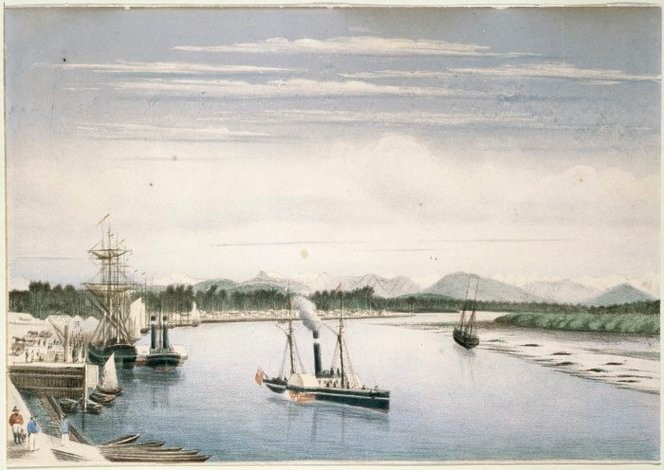
No-one would have built a town here if it hadn't been for the gold. Tucked behind a flimsy looking beach and at the edge of the Hokitika River it looked like a site made for flooding underneath the cataclysmic West Coast rainfall.
Rose Tremain imagines the town in the early goldrush in The Colour (p.147),
[It was] a place so lonely and far from everything, it looked as if it had never expected to become a town or anything resembling a town, but had imagined itself soon enough breaking adrift from the coast, like a raft, to wait for the tides to carry it away.
Of course, Hokitika was special back in the day. Gold made it special and given the difficulty of trans-Alpine travel back in the digger days catching a barque from Dunedin was pretty much de rigeur.
You still had to survive the storm-lashed 'heartless immensity' of the Tasman Sea (often as deck cargo) threatening to drive you on to the implacable cliffs of the lee-shore and then hope your captain and the tides would get you over the Hokitika River's treacherous, shifting bar 'calling to the keels of ships like a magnet' (Tremain, 2003 p.143-6).
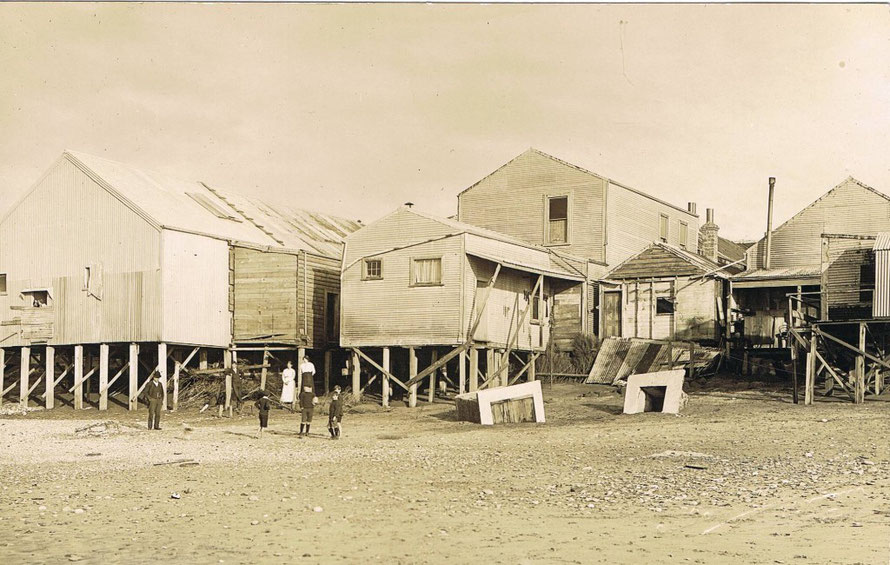
In the last third of the 19th century Hokitika had a population of 4,000 but this fell to 2,000 by 1900. It was a leading New Zealand town and its port was one of the busiest in the
country.
But it was all generated by the lure of gold. And when the gold ran out so did the boom times.
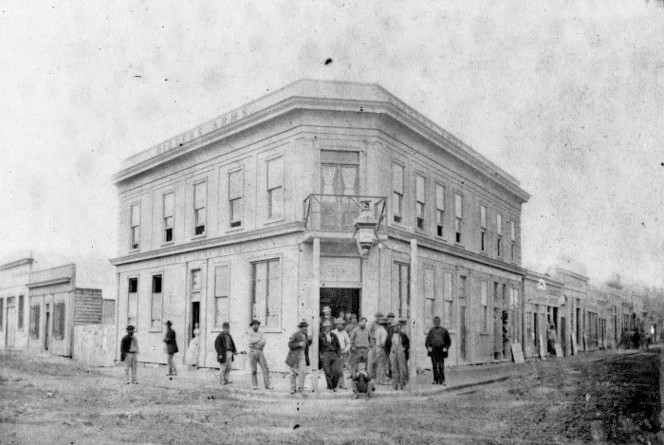
In 1867, the port of Hokitika ranked first in New Zealand in both the number of vessels entered inwards and in the total value of exports (principally gold). On one day there were 41 ships three or four deep alongside the wharf.
It was a spectacularly dangerous port, however, due to its notorious harbour bar created by the Hokitika River spewing its vast sediment load into the Tasman Sea with 108 strandings and 32 ships lost in the two years between 1865 and 1867.

Blaeneau Ffestiniog, in the mountains of Snowdonia in North Wales is one of the UK's wettest towns but its annual rain total falls 35 inches short of Hokitika's. And up in the Southern Alps
behind the town the rainfall rises to 9.4 metres a year.
Torrential downpours - 135mm (5.3 inches) fell in an hour a half near Lake Kaniere in March 1981 - lead to rapidly rising rivers and flood danger: a situation that is predicted to worsen with climate change (see Flooding & riverbed aggradation hazards www.wcrc.govt.nz. and SJ Stuart 2011 Observations and Modelling of Precipitation in the Southern Alps of New Zealand MSc Thesis particularly pp. 59-60 and p. 114 Victoria University Research Archive).

Given the rain, the remoteness and the pestilential, if misnamed, sandflies (actually in Hokitika the West Coast Blackfly - Austrosimulium ungulatum) you do wonder why anyone would choose to live here.
They say the locals get used to the sandflies having forsaken the rancid bacon rub perfected by the gold diggers for a mix of baby oil and Dettol or in extremis, but scientifically completely ineffective, a capful of kerosene in a jug of beer, a ton of Vegemite and an overdose of garlic (Te Ara).
And to avoid the floods and sea invasions most of the residential part of the town is stuck up on the low hill behind Hokitika.
| Hokitika Population 1926-2006 | |
| 1926 | 2403 |
| 1936 | 2704 |
| 1946 | 2742 |
| 1956 | 3032 |
| 1966 | 3258 |
| 1976 | 3530 |
| 1986 | 3472 |
| 1996 | 3321 |
| 2006 | 3070 |
|
Source: motu-www.motu.org.nz/wpapers/13_07.pdf |
|

The Hokitika Asylum
The population of the town rose from 2,403 in 1926 to a peak of 3,530 in 1976 before falling back to its current (2006) population of 3,070.
I suspect that much of this population growth was due to the growing number of patients at the Hokitika Asylum.
Hokitika was home to a large early psychiatric hospital - the Seaview Asylum - that operated from 1872 until 2009. At its peak in the 1940s it had between 500 and 600 patients (The total population of town was 3032 in 1956). It was for a long time the town's major employer (Wikipedia and The Press.co.nz).
In 1905 there were 138 male and thirty-seven female 'inmates' (as The Cyclopedia of New Zealand put it) in residence, in addition to four males and two females, who were out on
probation.
Seaview Terrace was also the location of Hokitika Goal, with 30 cells, that is such a large feature of The Luminaries.
We arrived into Hokitika after a stunning ride up the West Coast from Fox Glacier. The day had been spectacularly beautiful, colours glittering in the deep blue sun-filled sky. How the weather makes a difference on the West Coast.
The last bit of the ride began to pall. We detoured through the old gold town of Ross, and close to it we passed a working gold mine, where great big Volvo dumper trucks were pulling across State Highway 6 to a processing plant near the sea (see West Coast Gold Rush).
We didn't enter Hokatika by the coastal route but cut up backroads to go through Rimu and Woodstock - the last of the goldmine towns - before crossing the Hokitika River at Kaniere.
Little did I realise at the time that this was the epicentre of the West Coast gold rush and that the northern bank of the Hokitika River had featured so heavily in novels about it.

The whole area did have a worked-out feel as we swung over low scrubby hills to search out our hotel in the eastern hinterlands of the town recommended to us by a couple on the Milford Adventurer during our night on Milford Sound.
We wove our way past various small engineering workshops and a huge flower-filled replica miner's wheelbarrow. We climbed up a longer hill pasts turnoffs with names like 'Brickfield Road' and 'Pine Tree Street' until we got to Cement Lead Road.
The hotel was a block of semi-detached chalets/cabin in the bland modern style, a restaurant block with a large gravel car park, and a water feature with a mill wheel and ducks that looked they had been bought from a book called 'Motel Accessories for you'.
The place seemed deserted and bleak, stuck on a low ridgetop of cropped grassland with a view of not much at all.
We had arranged to have a key left for us in our cabin door and duly dumped our stuff in the perfectly nice but soulless accommodation.

The distance from Fox to Hokitika is only 100 miles (156km) but it seemed to have taken some time and energy and the anomie-inducing environment we had driven into was not helping.
There was a sign opposite the hotel telling us that we were in the Blue Spur gold mining area and the hills had the feeling of having been scoured out with high pressure hoses. The vegetation was all scrubby and mixed up - gorse and manuka and pine trees. It felt like the place had been done over and abandoned to its fate by the rapacious search for 'dust'.
We drove down to Hokitika through a modernish grid-plan suburb of bungalows on a broad shoulder that looked out over the Tasman Sea. It was neat and tidy but I felt at the time that I would have been screaming within two weeks if I'd had to live in one of the houses.
That happens on the West Coast. The so-called tourist drawcards are stunning, particularly if you luck in with the weather, but when they and the sun disappear it can go very bleak indeed.
I re-read Keri Hulme's The Stone People after our visit to the West Coast and she doesn't do much to change that impression. The book's story is harrowing enough but the descriptions of the rain, her boozing, her garden patch of dandelions and the emptiness of the country give the impression of a place that requires huge inputs of energy and willpower to overcome its wild lassitude, existential unboundedness and pestilential sandflies.
In a funny way The Stone People reminded me of the descriptions of the Outer Hebrides in Peter May's Lewis Trilogy and the ramshackle house at Carloway/Great Bernera.
Driving into Hokitika down the hill across the rail road tracks by the two ugly Catholic and United Church pastiche/warehouse churches I got the sense of a place that didn't belong, that didn't fit into its landscape, but that had been flung down willy nilly like a tablecloth thrown on the floor.

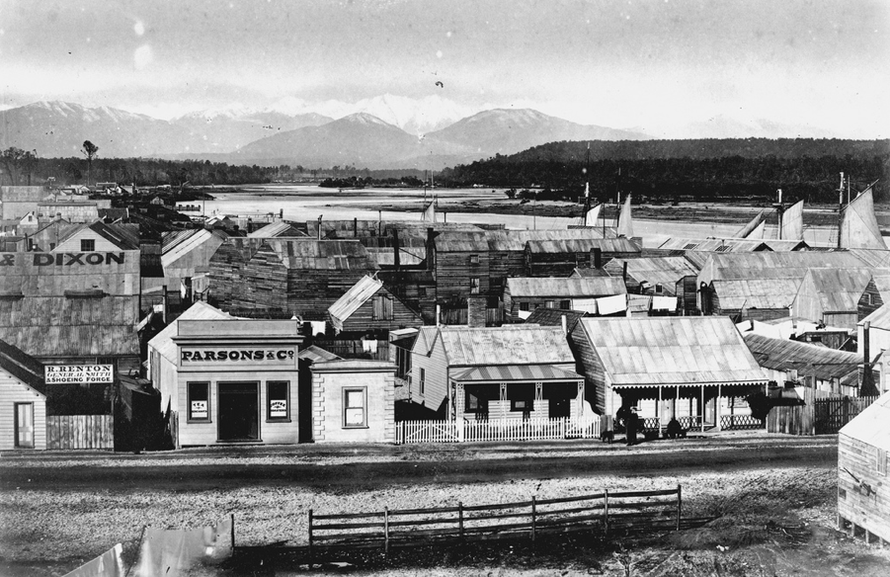
Hokitika has featured in a number of novels, all of which are written by women.
Charlotte Randall wrote a novel published in 2011 called Hokitika Town. This is also set at the height of the gold rush. English novelist, Rose Tremain, published The Colour in 2003 which is also set in the West Coast gold rush. More recently Eleanor Catton wrote The Luminaries (2013). And a previous novel to feature the West Coast, but in contemporary times, is of course, Keri Hulme's The Bone People (1984).
Catton's novel is a long complicated whodunnit with all sorts of interesting stylistic bells and whistles that runs out of steam and, at least for me, was ultimately disappointing. I was also increasingly unconvinced by the central part of the narrative that revolves around a fortune in gold dust sown into five dresses (see my blog post this).
Tremain's novel is more focused and gives a good sense of the brute work involved in prospecting.

Hokitika is pretty remote. Greymouth and Westport to the north struggle to shake of their post-post-industrial malaise and to the south other than the townships at the Franz Josef and Fox glaciers there is pretty much nothing until Wanaka 417 km distant. The road over the Haast Pass was not even opened until 1965.
Christchurch is 265 km (165 miles) and a three and a half hour drive distant over the Southern Alps via Arthur's Pass.
A train does still travel to Hokitika from Greymouth but it is only a freight train once a day when the seasonal flow of dairy products from the Westland Creamery is in full flow.
(For the Transalpine railway and early tramps across the Alps see my pages To Authur's Pass and Authur's Pass.)
And isn't the world full of ex-mining towns looking for a purpose and struggling to throw off the weight and population of the past? Think of Redruth, Camborne and Pool in West Cornwall with its World Heritage status or St Austell and the 'clay' villages in mid-Cornwall. Or the slate town of Blaeneau Ffestiniog in North Wales and the coal valley towns in the south.
In one sense Hokitika was lucky because the gold ran out fast, or at least the gold-gettable-by-gangs of diggers ran out fast. No sooner had the town mushroomed than it was rapidly declining. And as such most of the thrown-up wooden settlement could be either re-used, carted away or left to fall to pieces.

It's not my intention to do the place down but the world is full of old mining towns that don't know what to do with themselves. I worked for long years in Cornish ex-tin-mining towns and I know this hinterland with its old glories and current despairs and the countless hopes for renewal that sometimes manage to make it into town but generally do not or do not live up to their puffed-up promises.
These towns with their well established infrastructure and supplies of public and private housing become a magnet for people who think there is a better life waiting for them elsewhere. But it is often the people with the least resources and the most needs who end up living in what seem like the cheap and cheerful ex-mining and coastal towns of the UK. But which turn out to have deprivation and poverty scores that would make you think twice before going anywhere near them in search of the 'good life'.
But that almost fly-by-night character of the gold town works to Hokitika's disadvantage because here there are no quaint, close-packed streets of stone houses and most of what was there has gone save for a few blocky warehouses and the Town Hall.
Instead you have a grid of half a dozen broad streets that run parallel to the beach. The old wharf is no more but for a strange concrete 'replica' of a sailing ship and an anchor recently reinstated by the local Lions Club along with a replacement for the 'burnt picnic table'.

But there is just enough to give a sense of times past. Although to be honest, the focus of Hokitika's tourism offer (other than its Wild Food Festival) is geared to the pounama/greenstone phenomena. There was a gallery run as a cooperative that did things other than greenstone - particularly ceramics - but greenstone was the big draw.
This is not unsurprising because just a couple of kilometres up the road is the Arahura River, considered to be one of the sacred repositories of greenstone (for the fight by the local Maori, the Poutini Ngai Tahu, to wrest control of the riverbed back from the Crown see my pages Maori: the travails of the Ngai Tahu and more specifically The Arahura Deed.)
We liked the museum, housed in the old Carnegie Free Library building, with its mix of goldmining and dredging, greenstone and whitebait exhibits.
Apart from the massive Meccano model of a gold dredger the other exhibit that really caught my eye was a copy of the Arahura Deed of 1860 in which the Maori iwi of the West Coast, the Poutini Ngai Tahu, 'surrendered their customary title to nearly three million hectares in return for £300 in cash [£12,948 at 2005 UK prices] and 4,138 hectares in reserves.
(See my separate page on the Arahura Deed).
'The Carnegie Library building was one of more than 2,500 libraries worldwide funded by US steel magnate and philanthropist Andrew Carnegie in the early 20th century. Completed and opened in June 1908, it is one of 18 Carnegie libraries in New Zealand. The entrance steps were a typical feature of the libraries, signifying that learning elevates a person'.
See Te Ara
But Hokitika is looking forward and hopes to cash in on 'The Luminaries phenomenon'. Although at 832 pages of clever and acute story-telling that left me with a bitter taste of dissatisfaction it will clearly not be to everyone's taste.
Apparently the novel has the potential to propel Hokitika and the West Coast on to a bigger stage, says West Coast Business Development manager, Helen Wilson (June 2014). She's facilitating a meeting to 'get heads around the table' to consider the ‘big picture’ aspect of The Luminaries phenomenon reports the Greymouth Star of June 3rd 2014. There is talk of a TV mini-series.
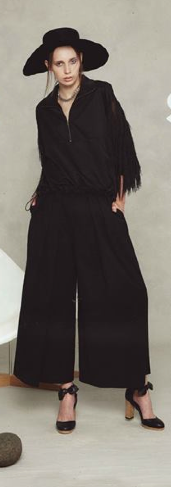
I have visions of lowering skies, Victorian dresses weighed down by more than 4kg of gold each and more grizzly moustaches than Movember in a kind of Kiwi Poldark.
Apparently one of New Zealand's top designers, Kate Sylvester, has brought out a 'Luminaries-inspired fashion range'. The collection is called 'West Coast' and was designed by Lucilla Gray and 'cleverly capture[s] the ruggedness of the coast with a tough yet feminine vibe', according to Black Magazine.
We headed north the next moring rising early in the dark. Outside a thick drizzle was falling. Down at the town a group of young Hokitika lads was setting off from a filling station on their scooters and mopeds to drive down to Haast. A few parents had turned up to see the kids off into the dark and rain.
We turned for Greytown and headed out across the Arahura River bound for Panakaiki Rocks and Nelson and our flight back up to Auckland and from there home.
